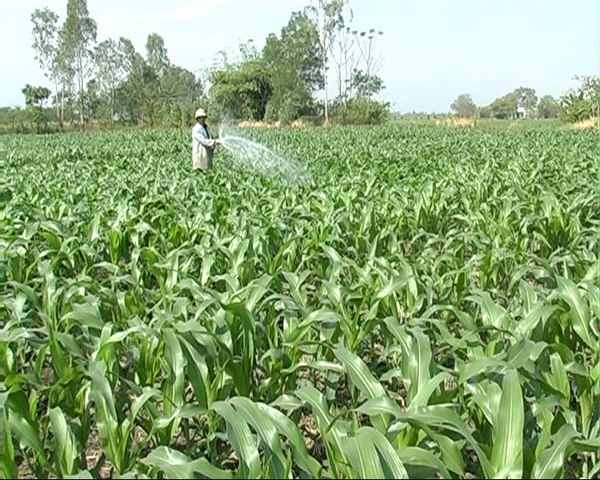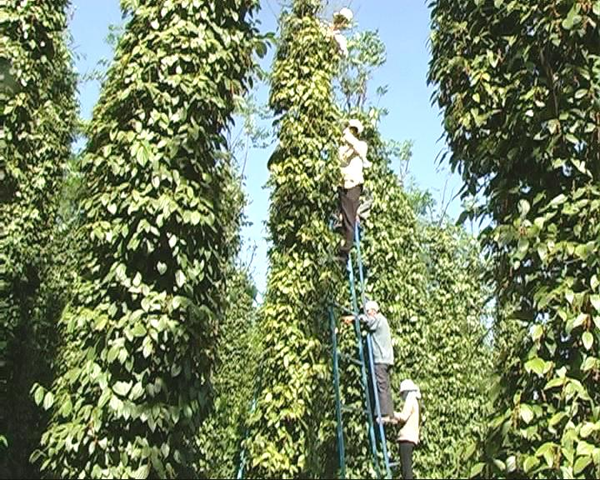1. Information on economic characteristics:
a. About Agriculture:
Xuan Loc is a midland mountainous district with a population of over 228 thousand people, a natural area of 72,619 hectares, of which 55,552 hectares are agricultural land. Promoting the industrialization and modernization of rural agriculture with the main contents such as: shifting the structure of agricultural and rural economy towards commodity production, promoting the development of industry and services, building and developing infrastructure, implementing irrigation, mechanization, developing rural markets; encouraging economic sectors to invest in agriculture, developing cooperative economy, farm economy. The Party Executive Committee of the district has focused on directing the consolidation of cooperative economy, encouraging the development of farm economy, building models of high-yield clubs, and club unions, creating new breakthroughs in agricultural production; Those policies have created high consensus among Party committees and authorities from district to grassroots levels and received positive response from the majority of farmers, affirming their effectiveness, correctness, and conformity to "Party's will - people's heart".
In the field of agriculture and forestry, based on natural factors and socio-economic conditions, the planning has been oriented into 4 sub-regions for development, specifically as follows:
Sub-region I:Including Xuan Hiep, Suoi Cat communes and Gia Ray town, in which the center of the sub-region is Gia Ray town, the main economic structure is industry - services and agriculture. The total natural area is 5,526.09 ha, accounting for 7.6% of the total natural area of the district; in which the agricultural land area is 3,259.38 ha, accounting for 7.06% of the agricultural land area of the district.
Sub-region II:Including the communes of Xuan Dinh, Bao Hoa, Xuan Phu and Lang Minh, in which the center of the sub-region is Bao Hoa; the main economic structure is the cultivation of perennial crops, annual crops, specialty crops with high intensive farming level and farm animal husbandry. The total natural area is 8,716.74 ha, accounting for 12% of the total natural area of the district; in which the agricultural land area is 7,432.85 ha, accounting for 16.08% of the agricultural land area of the district.
Sub-region III:Including Xuan Tam, Xuan Hung and Xuan Hoa communes, of which Xuan Hung is the center of the sub-region, the main economic structure is agriculture-forestry, livestock farms and aquaculture. The total natural area is 31,315.18 ha, accounting for 43.12% of the total natural area of the district; of which the agricultural land area is 16,082.47 ha, accounting for 34.78% of the agricultural land area of the district.
Sub-region IV:Including the communes of Xuan Bac, Suoi Cao, Xuan Tho, Xuan Truong and Xuan Thanh. This is a sub-region specializing in pepper, cashew, clean vegetables, and livestock farms. The total natural area is 27,078.44 hectares, accounting for 37.28% of the total natural area of the district; of which the agricultural land area is 19,443.08 hectares, accounting for 42.08% of the agricultural land area of the district.
2. Planning for crop development:
The district has implemented many areas with production value from 100 million to 250 million/ha/year such as: production areas of 1 corn crop + 2 rice crops and 2 corn crops + 1 rice crop in Lang Minh (area 400 ha), Suoi Cat (area 123 ha), Xuan Phu (area 450 ha); pepper in Suoi Cao, Xuan Tho (area 590 ha); mango in Xuan Hung (area 150 ha) and vegetables in Xuan Phu, Xuan Bac (area 270 ha).
+ For corn:
Thanks to the effective exploitation of irrigation works and the application of scientific and technical measures, the corn area in 2010 reached 11,732 hectares. The average yield of the year reached 69 tons/ha, of which the average yield in high-yield clubs reached 84 tons/ha, with some households achieving a yield of 120-130 tons/ha. The corn area is mainly concentrated in the communes of Xuan Phu, Lang Minh, Xuan Bac, Xuan Thanh, Xuan Truong, Suoi Cao, Xuan Tam, and Suoi Cat.
High Yield Club 2 Rice - 1 Corn Lang Minh Commune
+ For rice plants:
The area in 2010 was 12,732 hectares. The average rice yield was 48 quintals/hectare. The rice area is mainly concentrated in the communes of Xuan Bac, Xuan Phu, Xuan Tho, Lang Minh, Xuan Hiep, and Xuan Thanh.
Demonstration planting of new rice varieties in Xuan Phu field, yield reaches 6-7 tons per hectare.
+ For vegetables:
The vegetable area in 2010 reached 3,165 hectares, the average yield of the whole district reached 151.9 quintals/ha. In particular, some households in the vegetable club had a yield of 300 - 350 quintals/ha. The average income per hectare reached 150 - 200 million VND/year with a rotation cycle of 5-7 times/year. The area is mainly concentrated in the communes of Xuan Bac, Xuan Phu, Xuan Thanh, Xuan Truong, Xuan Hiep.
Pepper club achieved NS 10 tons in Xuan Tho commune
Livestock development planning:
- The total planned area for livestock development promotion in Xuan Loc district in phase I is 3,982 ha, phase II is 13,986 ha in 14 communes (except Gia Ray town). The whole district currently has 214 livestock farms with 54,590 pigs, 705 cows, 937,545 chickens, 200 goats, 136,000 quails, including: 125 pig farms, 13 cow farms, 61 chicken farms, 01 goat farm, 09 quail farms and 05 mixed livestock farms (chickens and pigs). The total production and business capital of the livestock farms is 181,865 billion VND. The production value of the farms in 2009 was 142,284 billion VND, accounting for 11% of the production value of the agricultural sector.
b. About Forestry:
Although forestry has a very modest position in the development of agriculture, forestry and fisheries , it plays an important role in protecting the environment and improving the groundwater regime for the Western region , where the climate is relatively dry and hot.
The forest management board has mobilized resources from local people , businesses and state investment capital for planting , protecting and trading forests. It has determined the forest tree structure suitable to the function of each type of forest and the land characteristics of each area. There is a good combination between the main planted forest tree, hybrid acacia, and multi-purpose trees such as rubber and cashew on production forest land.
The models of planting cashew , rubber , and hybrid acacia all gave good results. During the period from 2005 to 2008, the output of forest products exploited in production forests continuously increased , from 12,534 m3 in 2005 to 27,770 m3 in 2006 and 31,150 m3 in 2007. In addition to bringing economic efficiency, it also has practical effects on environmental protection and diversifying types of land use , as well as improving the efficiency of using home garden land and specialized land through scattered tree planting.
On the basis of the approved planning of 3 types of forests to stabilize the concentrated forest area with high-yield and suitable forest trees , focusing on scattered forest planting.
Promote the application of technical advances in new planting and care to increase productivity and efficiency , provide stable raw materials for the pulp processing industry and wood furniture production , create more jobs for rural areas , contribute to environmental protection , beautify the landscape and develop tourism.
Planting selected forest tree varieties , initially using hybrid acacia , in the long term, depending on the achievements in breeding, will plant new suitable varieties. On protective forest land, planting suitable forest trees such as oil , star anise, etc. In addition to forest trees , planting multi-purpose trees such as rubber , cashew , but in the future, the area of cashew should be gradually reduced , and the area of rubber and timber should be gradually increased.
Apply technical advances in breeding and silviculture to increase tree survival rate , increase productivity , and proactively prevent forest fires.
3.4. Aquaculture :
Aquaculture in Xuan Loc mainly takes advantage of the water surface of irrigation works and small ponds. The aquaculture area in 2008 was 715 hectares , with a total production value of 16.8 billion VND at 1994 fixed prices and 29.3 billion VND at current prices ( 2008 ) .
Utilizing all types of water surfaces to develop freshwater aquaculture , contributing to improving the efficiency of land and water resource use and increasing income for farmers. Farmers constantly absorb and apply technical and technological advances in breeds , feed , nutrition , and disease prevention.

